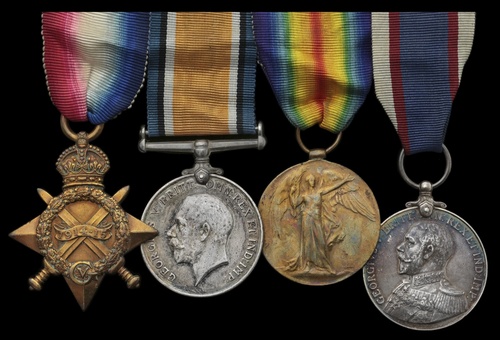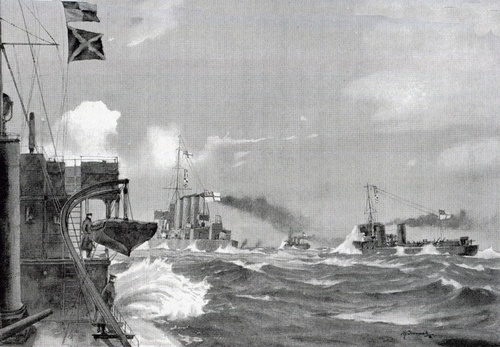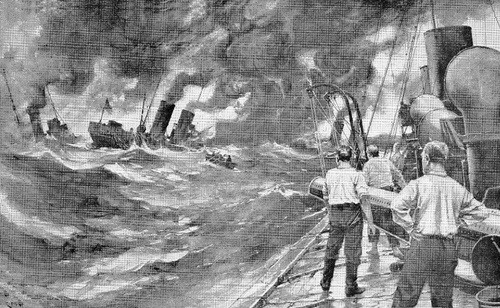Auction: 22003 - Orders, Decorations and Medals
Lot: 356
17 OCTOBER 1914: VICTORY OFF THE TEXEL
A Great War campaign group of four awarded to Able Seaman E. J. Hooker, Royal Fleet Reserve, late Royal Navy, who was present at Captain Cecil Fell's spectacular victory off the Dutch coast on 17 October 1914, when four German destroyers were sunk within 90 minutes
For his own part - in what became known as the battle of Texel - Hooker served in the destroyer H.M.S. Lennox, which ship lay waste the S115, so much so that her boarding party found just one remaining German to take her surrender
1914-15 Star (SS. 3840 E. J. Hooker, A.B., R.N.); British War and Victory Medals (SS. 3840 E. J. Hooker, A.B., R.N.); Royal Fleet Reserve L.S. & G.C., G.V.R. (SS. 3840 (Ch. B. 11552) E. J. Hooker, A.B., R.F.R.), mounted as worn, contact marks, nearly very fine or better (4)
Edward James Hooker was born in Maidstone, Kent on 22 January 1891 and entered the Royal Navy as an Ordinary Seaman in January 1912.
Victory off the Texel
By the outbreak of hostilities in August 1914, he was serving in the destroyer H.M.S. Lennox and it was in this capacity that he quickly saw action in Captain Cecil Fell's spectacular victory, fought off the 'Broad Fourteens', about 40 miles S.W. of the Texel, on 17 October 1914. Deeds That Thrill The Empire takes up the story:
'On 17 October 1914, a spirited skirmish was fought off the Dutch coast, which proved in the neatest and most complete manner the soundness of British policy. In the morning five British vessels steamed out of Harwich to take over a certain patrol on the other side of the North Sea. In the evening they returned with a handful of prisoners, leaving four German destroyers at the bottom.
In command of the flotilla was Captain Cecil Fox, whose previous ship, the cruiser Amphion, had been blown up and sunk by a German mine on the second day of the War. He was at once given command, first of the Faulknor, and then of the Undaunted, a light cruiser of an exceptionally useful type, designed especially for the extermination of hostile torpedo craft. She displaced 3,800 tons, but two inches of armour protected her waterline, and she carried the powerful armament of two 6-inch and eight 4-inch guns, while her speed - she burnt oil fuel exclusively - could be raised to over thirty knots at a pinch.
Accompanying Undaunted were the destroyers Lance (Commander W. de M. Egerton), Lennox (Lieutenant-Commander Clement R. Dane), Legion (Lieutenant-Commander Claud F. Allsup) and Loyal (Lieutenant-Commander F. Burges Watson). These vessels belonged to the latest type of destroyer then in commission with the British Fleet, each carrying three 4-inch guns and four torpedo tubes on a displacement of 965 tons. Nominally, their speed was only twenty-seven knots, but actually their engine-room staffs could get a good deal more out of them.
The little flotilla made its way across the North Sea, and then turned north as it neared the Dutch coast. They had not proceeded far when the smoke of four vessels was seen approaching from the north, and without an instant's hesitation Captain Fox ordered his vessels to clear for action and chase at full speed. The excitement on board may well be imagined, for nearly everyone there had seen the Amphion stricken to death by the most cowardly weapon known in warfare, and all of them were keen on avenging the brave men who had gone down with her.
As soon as the Germans caught sight of our boats they turned and fled; but while Von Tirpitz had been building destroyers, the British Admiralty had been building "destroyer-destroyers" and as our vessels rushed along at thirty miles an hour, with the sea and the spray washing them from end to end, the enemy rose higher and higher above the horizon. It was not exactly a stern chase. The enemy were only about a hundred miles from their base in the Ems - less than four hours' steaming - and Captain Fox manoeuvred his flotilla so as to make certain of cutting them off before they could get home, or help reach them.
The Undaunted opened fire soon after two o'clock with her 6-inch bow-chaser, and kept firing at intervals, while the destroyers, ranged up on either side, reserved their fire until their smaller 4-inch guns could be relied on to cover the range. Presently the Germans altered course, evidently in the hope of getting into the neutral waters of Holland, but the movement was a fatal one. As their broadsides opened out to our ships, a 6-inch shell from Undaunted caught one of them squarely under the bridge. There was a great burst of smoke and flame, and the wounded ship heeled over almost on to her beam ends under the shock of the impact. Then she slowly righted herself, but her decks were already level with the water, and in less than two minutes from the Undaunted's hit she canted her stern into the air and dived to the bottom bows first.
In the meantime, the pace had not slackened. Indeed our vessels had by this time so reduced the range that the enemy began firing torpedoes. Luckily, all of these were either badly aimed, or else were dodged by our fast and handy vessels as the tell-tale line of the air-bubbles was seen approaching them. The Undaunted in particular had a narrow escape, for one weapon passed within a very few yards of her stern. Had it made a hit, Captain Fox would assuredly have had his second ship sunk beneath him.
The second enemy destroyer was not long following the first, though her end was more lingering. As the 4-inch semi-automatic guns of our destroyers swept her decks with their 31-lb. shells, masts, funnels, boats, guns, searchlights and other fittings were mown away like corn before the scythe. It is to the Germans' credit that in spite of the odds opposed to them they never for an instant showed a sign of surrender from start to finish, and this vessel, by now little more than a razed hull, disappeared beneath the waves a hissing, seething mass of crumpled, battered and blazing metal.
The end for the last two enemy destroyers was not long in coming. It was impossible for our men to stop and lower boats to pick up survivors of the sunken vessels at this stage, for to bring our ships to a standstill would have been to multiply the risk of being torpedoed by the remaining German destroyers. The only practicable course - especially in view of the probability that fresh German ships, warned by wireless, would soon be steaming out of Ems - was to finish them off with as little delay as possible. In the face of the concentrated fire of the five British ships, the two German destroyers, already hit and maimed, had no chance. Both of them had been sent to the bottom by half-past three - within ninety minutes of the beginning of the action.
Their principal work accomplished, our boats set about rescuing whom they could; but the gunfire had been so accurate and destructive, and the annihilation of the enemy so complete, that only two officers and twenty-nine men could be found, and of these one officer was so badly injured that he died on the way to Harwich. It is estimated that the Germans lost at least two hundred and fifty officers and men in this action, besides four of their much-boasted destroyers. The vessels lost were the S. 115, S. 117, S. 118 and S. 119 ... The German destroyers displaced 413 tons each, and carried an armament of three 4-pounders, two machine-guns and three torpedo tubes. They cost about £50,000 each.
Only one of our ships sustained even slight damage, and our loss in men was five wounded, of whom one succumbed to his injuries. Captain Fox and the commanding officers of the destroyers each received a "Letter on Vellum" expressing the Admiralty's appreciation of their work on this occasion.'
Subsequent career
In April 1917, Hooker removed from the Lennox to the Sharpshooter and, in October of the same year, to yet another destroyer, the Ullswater. And he was likewise employed at the time of the latter's loss to the UC-17 off the Dutch coast in August 1918; see the Imperial War Museum's art collection for a related painting of her loss by Charles Pears (1873-1958).
Hooker enrolled in the Royal Fleet Reserve in March 1919 and finally came ashore in the summer of 1921.
Subject to 20% VAT on Buyer’s Premium. For more information please view Terms and Conditions for Buyers.
Sold for
£190
Starting price
£140









